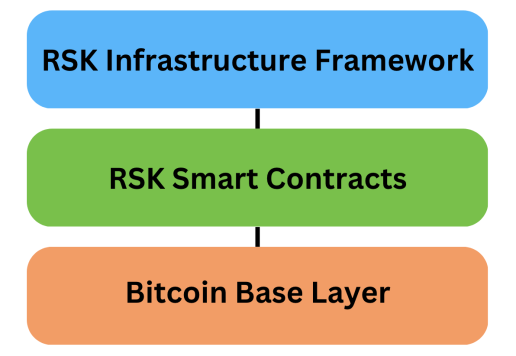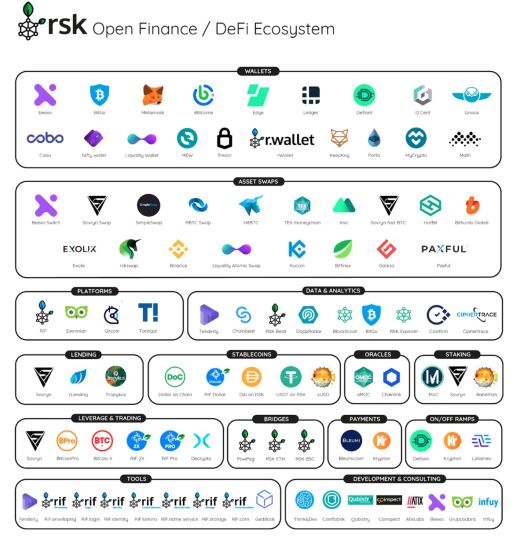Disclaimer: Content about scaling solutions and projects is not an endorsement. All content is solely for educational purposes.
Bitcoin and Ethereum have emerged as two leaders within blockchain. While Bitcoin currently serves as a digital store of value, Ethereum acts as a productive platform for decentralized finance and a gateway to Web3 application.
What if Bitcoin could maintain its security and decentralization, all while adding the utility found on Ethereum?
Now, this is possible with RSK.
This article will cover RSK, how it enables Bitcoin’s decentralized applications (dApps), and its use cases as a smart contract platform.
What is RSK?
RSK (also called Rootstock) is a general purpose smart contract platform secured by the Bitcoin network.
Founded by RSK Labs, RSK aims to address the shortcomings of Ethereum by leveraging Bitcoin's unmatched stability, security, and economic power. By porting its smart contracts over from Ethereum, RSK makes all Ethereum applications compatible with the Bitcoin blockchain. Compared to Ethereum, RSK can provide about 10 times faster transaction speeds and 50 times cheaper gas fees.
Overall, the RSK network has three defining features for improving Bitcoin:
- Scalability
The RSK blockchain is a scaling solution for the Bitcoin network. Transactions on RSK can be confirmed, bundled, and then sent to Bitcoin’s base layer for final settlement. Bundling increases Bitcoin’s throughput, therefore expanding the network’s capacity to host many more users, applications, and transactions.
- Near-instant settlement
RSK creates new blocks about every 33 seconds. This is remarkably faster than Bitcoin’s 10-minute block time. RSK can also process about 10-20 transactions per second (tps), which is more efficient than Bitcoin’s capacity of about 5 transactions per second.
- Smart contracts
Rootstock's smart contracts are fully autonomous and eliminate the need for an intermediary to facilitate transactions. Since Bitcoin’s base layer has limited programmability, RSK implements smart contract functionality to build decentralized applications on top of the larger Bitcoin network.
RSK Under the Hood

RSK is a sidechain - meaning it runs adjacent to the Bitcoin blockchain and connects via a two-way bridge.
The RSK sidechain design has a few unique mechanisms compared to other Bitcoin layers:
Merged Mining
The RSK blockchain uses the same Proof-of-Work (PoW) consensus algorithm as Bitcoin, except miners can generate blocks significantly faster than Bitcoin’s base layer. These RSK blocks are mined through a process called “merged mining.”
Since both blockchains use the same consensus, miners can engage in merged mining to mine for the Bitcoin and RSK blockchains simultaneously. Bitcoin and RSK consume the same mining computing power, so miners can contribute hash rate to mine blocks on RSK. Ultimately, merged mining can increase a miner’s profitability without requiring additional resources.
Merged mining allows RSK to validate transactions, create blocks, and send them to Bitcoin. With this mining process, users can have peace of mind knowing that RSK smart contracts benefit from the battle-tested security of the Bitcoin blockchain.
Powpeg
Powpeg is the two-way bridge for transferring Bitcoin to and from the RSK blockchain.
The Powpeg protocol is made possible with RSK’s asset, smartBTC (RBTC).
Technically, the RSK platform does not have its own native gas token. Instead, RSK uses smartBTC (RBTC), which is issued at a 1:1 ratio against BTC locked on Bitcoin. RBTC will always possess the same value as BTC and is used to pay transaction fees on RSK.
Bridging funds between RSK and Bitcoin is controlled by 2 main mechanisms: a vault and a smart contract. Transferring Bitcoin to RSK is a process known as “pegging-in”, and requires the user to lock an amount of BTC into a vault on the Bitcoin network. This enables unlocking the corresponding BTC amount on RSK.
Conversely, transferring BTC back to the Bitcoin network from RSK (pegging-out) requires the user to send an amount of RBTC to a smart contract on RSK. This subsequently unlocks the corresponding amount of BTC from the vault on Bitcoin.
RSK Virtual Machine (RVM)
An advantageous component of RSK is its interoperability with Ethereum smart contracts. The RSK Virtual Machine (RVM) is based on the Ethereum Virtual Machine, allowing for the execution of Ethereum smart contracts on RSK. Developers can seamlessly use the same code, tooling, and libraries when building RSK applications. In turn, this gives the Ethereum community a cheaper, faster alternative for interacting with their favorite dApps.
This means that RSK developers can code with Solidity - the same smart contract programming language used on Ethereum.
Users also can send their RSK assets to Metamask, a popular ETH digital wallet.
What Is Being Built on RSK?

Source: rsk.co
RSK’s goal is to support an inclusive and easily accessible financial system on the world’s leading blockchain, Bitcoin. Through the RVM, developers can create new dApps, or continue building on top of their existing applications on Ethereum.
Here are some notable projects that are helping grow the RSK network for Open Finance:
RSK DeFi apps
- Sovryn - A non-custodial, smart contract platform for lending, borrowing, and margin trading with Bitcoin.
- RSK Swap - A decentralized exchange on RSK that is forked from Ethereum’s Uniswap protocol.
- Tropykus - A digital savings protocol that removes many hurdles and limitations present in traditional banking.
RSK stablecoins
- Dollar on Chain (DoC) - A token that is pegged 1:1 to the US Dollar, and is crypto-collateralized in Bitcoin.
- BRZ Token - A multi-chain stablecoin that pegs to the Brazilian Real.
- RSK Dai (rDai) - An alternative to Dai stablecoins on Ethereum.
RSK wallets
RSK bridges
Where Can You Buy RBTC?
For users looking to explore the RSK ecosystem, there are currently 3 methods for getting started with RSK Bitcoin, RBTC.
- Converting BTC to RBTC with RSK’s built-in Powpeg
- Crypto Wallets such as Defiant or Liquality
- Decentralized Exchanges such as Bitfinex and KuCoin
RSK: DeFi for the Bitcoin Blockchain
The RSK sidechain was purposefully designed for higher scalability and Bitcoin DeFi.
Through Powpeg and merged mining, users can securely bridge off of the Bitcoin blockchain and unlock smart contract functionality with their BTC. Using RBTC, Bitcoin holders can explore a new ecosystem of decentralized finance applications that are built directly on top of Bitcoin. RSK also provides novel utility with its support for the EVM, making it easy for users and developers to interact with Ethereum smart contracts.
Furthermore, RSK drastically improves Bitcoin’s performance by enabling significantly faster and more efficient transactions than its base layer.
More of the Bitcoin community will be turning to layered solutions for adding value and expanding the functionality of the Bitcoin ecosystem. A layer like RSK helps enable a multichain world, where external smart contracts and applications can be seamlessly added to expand Bitcoin network utility.

